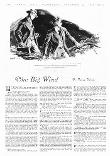AustLit
Latest Issues
Publication Details of Only Known VersionEarliest 2 Known Versions of
Works about this Work
-
“Big Wind, He Waiting There” : Vance Palmer’s Cyclones of Apocalypse and Their Power of Revelation
2016
single work
criticism
— Appears in: Etropic , vol. 15 no. 1 2016;'Prior to writing his 1947 novel, Cyclone, Queensland author Vance Palmer drafted out many of his ideas for the story in three earlier short stories: ‘Cyclone’(1932), ‘Big Wind,’ and ‘Tempest,’ both published in 1936. In these stories and the later novel, Palmer develops the cyclone as trope of apocalypse, an unveiling and realization of the new inherent within the destruction of the old. As a result of experiencing both the terror and the mystery of the apocalyptic cyclonic event, Palmer’s characters realize they have transcended fears and inadequacies within themselves, enabling them to re-create new lives and new worlds.
-
“The Cyclone Which Is at the Heart of Things” : The Cyclone as Trope of Place and Apocalypse in Queensland Literature
2016
single work
criticism
— Appears in: Etropic , vol. 15 no. 2 2016;'In order to better understand and respond to the tropics as part of the global environment, we need to accept the unique features of the regional weather, such as cyclones, and be prepared to embrace their larger meaning for life in the tropics. In a physical landscape impacted by some 207 tropical cyclones since 1858, Queensland writers have attempted to incorporate both the terror and the sublime of the cyclone into their sense of place as they have attempted to find context for the unpredictable, chaotic and destructive tropical cyclone within their ostensibly tamed and ordered natural landscape. Consequently, the cyclone has become a defining symbolic metaphor of not only physical but also of literary tropical Queensland.
'Some Queensland writers have perceived within cyclones the Burkean sublime or personal revelation, while others have seen it as motivation for community strength, cooperation and compassion. For some, the purpose of the cyclone is divine retribution, but to others it’s an apocalyptic event revealing a rare second chance for revelation and renewal. This paper will examine a range of such perceptions within Queensland literature as part of the search for meaning within cyclonic chaotic events.' (Publication abstract)
-
“Big Wind, He Waiting There” : Vance Palmer’s Cyclones of Apocalypse and Their Power of Revelation
2016
single work
criticism
— Appears in: Etropic , vol. 15 no. 1 2016;'Prior to writing his 1947 novel, Cyclone, Queensland author Vance Palmer drafted out many of his ideas for the story in three earlier short stories: ‘Cyclone’(1932), ‘Big Wind,’ and ‘Tempest,’ both published in 1936. In these stories and the later novel, Palmer develops the cyclone as trope of apocalypse, an unveiling and realization of the new inherent within the destruction of the old. As a result of experiencing both the terror and the mystery of the apocalyptic cyclonic event, Palmer’s characters realize they have transcended fears and inadequacies within themselves, enabling them to re-create new lives and new worlds.
-
“The Cyclone Which Is at the Heart of Things” : The Cyclone as Trope of Place and Apocalypse in Queensland Literature
2016
single work
criticism
— Appears in: Etropic , vol. 15 no. 2 2016;'In order to better understand and respond to the tropics as part of the global environment, we need to accept the unique features of the regional weather, such as cyclones, and be prepared to embrace their larger meaning for life in the tropics. In a physical landscape impacted by some 207 tropical cyclones since 1858, Queensland writers have attempted to incorporate both the terror and the sublime of the cyclone into their sense of place as they have attempted to find context for the unpredictable, chaotic and destructive tropical cyclone within their ostensibly tamed and ordered natural landscape. Consequently, the cyclone has become a defining symbolic metaphor of not only physical but also of literary tropical Queensland.
'Some Queensland writers have perceived within cyclones the Burkean sublime or personal revelation, while others have seen it as motivation for community strength, cooperation and compassion. For some, the purpose of the cyclone is divine retribution, but to others it’s an apocalyptic event revealing a rare second chance for revelation and renewal. This paper will examine a range of such perceptions within Queensland literature as part of the search for meaning within cyclonic chaotic events.' (Publication abstract)




